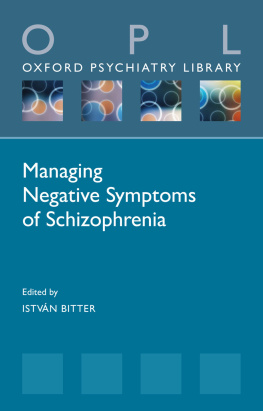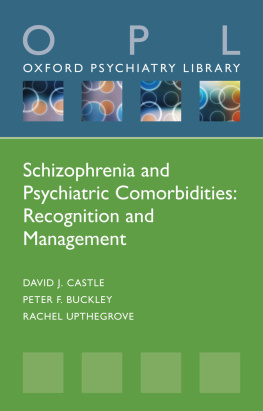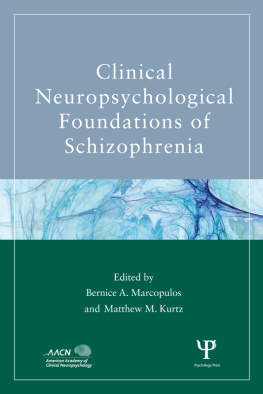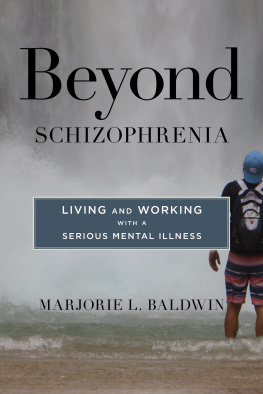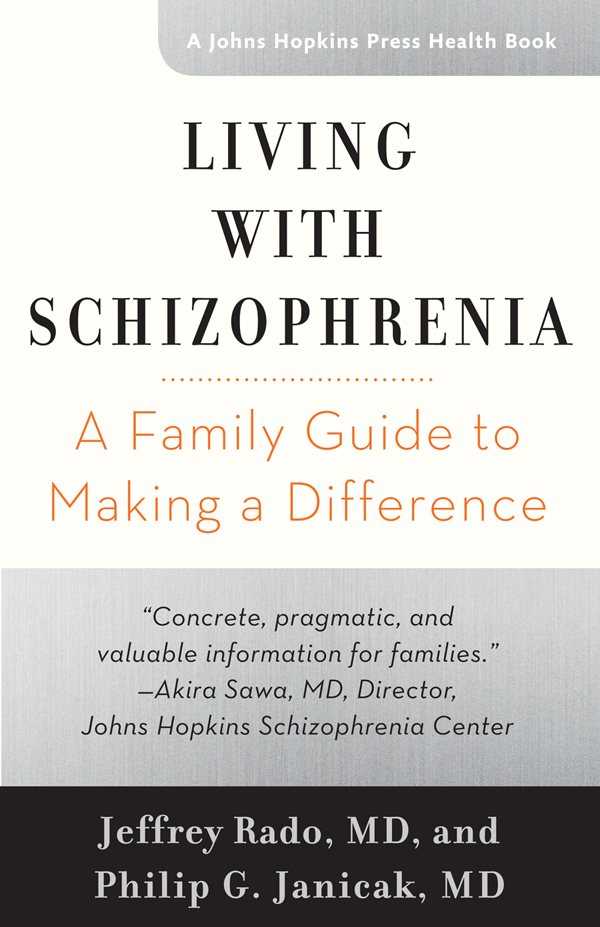Contents
Guide
Living with Schizophrenia
A Johns Hopkins Press Health Book
LIVING
WITH
SCHIZOPHRENIA

A Family Guide to Making a Difference
J EFFREY R ADO , MD, and P HILIP G. J ANICAK , MD
JOHNS HOPKINS UNIVERSITY PRESS
Baltimore
Note to the reader: This book is not meant to substitute for medical care of people with schizophrenia, and treatment should not be based solely on its contents. Instead, treatment must be developed in a dialogue between the individual and his or her physician. Our book has been written to help with that dialogue.
Drug dosage : The authors and the publisher have made reasonable efforts to determine that the selection of drugs discussed in this text conforms to the practices of the general medical community. The medications described do not necessarily have specific approval by the U.S. Food and Drug Administration for use in the diseases for which they are recommended. In view of ongoing research, changes in governmental regulation, and the constant flow of information relating to drug therapy and drug reactions, the reader is urged to check the package insert of each drug for any change in indications and dosage and for warnings and precautions. This is particularly important when the recommended agent is a new and/or infrequently used drug.
2016 Johns Hopkins University Press
All rights reserved. Published 2016
Printed in the United States of America on acid-free paper
9 8 7 6 5 4 3 2 1
Johns Hopkins University Press
2715 North Charles Street
Baltimore, Maryland 21218-4363
www.press.jhu.edu
Library of Congress Cataloging-in-Publication Data
Names: Rado, Jeffrey, 1970 author. | Janicak, Philip G., author.
Title: Living with schizophrenia : a family guide to making a difference / Jeffrey Rado, MD, and Philip G. Janicak, MD.
Description: Baltimore : Johns Hopkins University Press, [2016] | Includes bibliographical references and index.
Identifiers: LCCN 2016010033| ISBN 9781421421421 (hardcover : alk. paper) | ISBN 1421421429 (hardcover : alk. paper) | ISBN 9781421421438 (pbk. : alk. paper) | ISBN 1421421437 (pbk. : alk. paper) | ISBN 9781421421445 (electronic) | ISBN 1421421445 (electronic)
Subjects: LCSH: SchizophreniaPopular works. | SchizophreniaTreatmentPopular works. | SchizophreniaFamily relationships.
Classification: LCC RC514 .R26 2016 | DDC 616.89/8dc23 LC record available at https://lccn.loc.gov/2016010033
A catalog record for this book is available from the British Library.
Special discounts are available for bulk purchases of this book. For more information, please contact Special Sales at 410 -- 6936 or specialsales@press.jhu.edu.
Johns Hopkins University Press uses environmentally friendly book materials, including recycled text paper that is composed of at least 30 percent post-consumer waste, whenever possible.
Contents
Preface
The idea for this book grew out of our time working with people affected by schizophrenia, a condition that is perplexing to patients and caregivers alike. Much about schizophrenia is misunderstood or poorly understood. We felt there was a need for a brief yet informative resource for those seeking to better understand this disordera guide that directly spoke to you, the person diagnosed with schizophrenia, and you, the family member. Our goal with this book is to present information in plain English without medical jargon; to be neither too lengthy nor too simplistic; and to convey an understanding and empathy that goes beyond a medical textbook.
When we first meet with a person who has schizophrenia and her family, we sit down together and try to help them make sense of this condition. We try to take into account their belief system, values, and cultural background. This initial conversation allows us to discover what is of most concern to the person who has schizophrenia and her family. In this way, we can better understand each other and find a mutually agreeable starting point for discussion. Ultimately, we try to convey to them the knowledge and understanding that will allow them to best achieve recovery and healing.
Between us, we have more than sixty years of experience working with individuals and their families. Philip Janicak has written more than one hundred articles, chapters, and books and given countless lectures nationally and internationally on the topic of schizophrenia. In that context, he has educated many of the psychiatrists practicing today. As a board-certified psychiatrist and internal medicine specialist, Jeffrey Rados focus has been to improve both the mental and the physical health of persons with schizophrenia. Both of us have conducted research in the area of mental illness and more specifically on treatment approaches to schizophrenia.
How to Read This Book
The book begins, in explores the causes of schizophrenia, including genetics, brain changes, and environmental factors.
), including how treatments are modified for the different stages of schizophrenia, as well as a description of the wide variety of supportive therapies that often provide great benefit to people with schizophrenia and their families.
is an important discussion about how to enhance the physical health of the person with schizophrenia.
We note important points in each chapter for easy reference. Some chapters include Internet resources and other references. The book is relatively short, reflecting our goal of making it possible to read in one sitting, if the reader wishes. The chapters can be read separately, and the index makes it easy to find specific topics of interest.
Being told that you have schizophrenia can be a traumatic experience. Learning that a loved one has schizophrenia can be equally distressing. Our wish is for this book to empower you with the knowledge and awareness you need to promote wellness and to begin the healing process.
Our inspiration is youthe individuals and families coping every day with this challenging illness.
Living with Schizophrenia
What Is Schizophrenia?
When you, or a person close to you, were first diagnosed with schizophrenia, your first reaction might have been fear and confusion, wondering, How could this have happened? Or your overwhelming emotion might have been disbelief: It cant be true . The image of a person with schizophrenia that is presented in movies and TV is often both negative and inaccurate. For instance, the individual is often portrayed as violent and unpredictable, when in fact most people who have schizophrenia are not dangerous. Despite what is commonly thought, schizophrenia does not involve switching personalities or multiple personalities. Schizophrenia is a disabling disorder, involving abnormal brain function that alters the way people perceive the world. It affects all areas of functioningat school, at work, and in relationshipsand impairs peoples ability to care for themselves.
Family members may have noticed that their relative with schizophrenia acts and thinks differently from most other people. Prominent symptoms of schizophrenia include hallucinations and delusions, changes in behavior and speech, and changes in how emotions are expressed. Additionally, people who have schizophrenia may experience changes in mood (such as depression), feel anxious, have difficulty focusing and concentrating, and make unusual movements.



